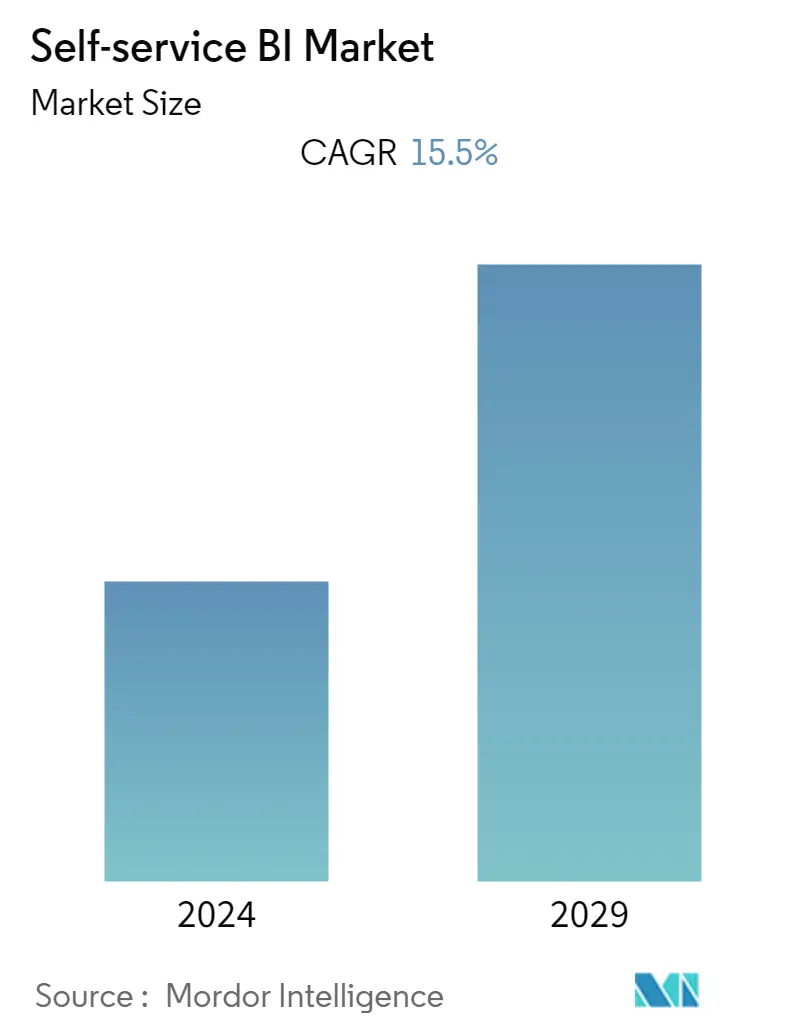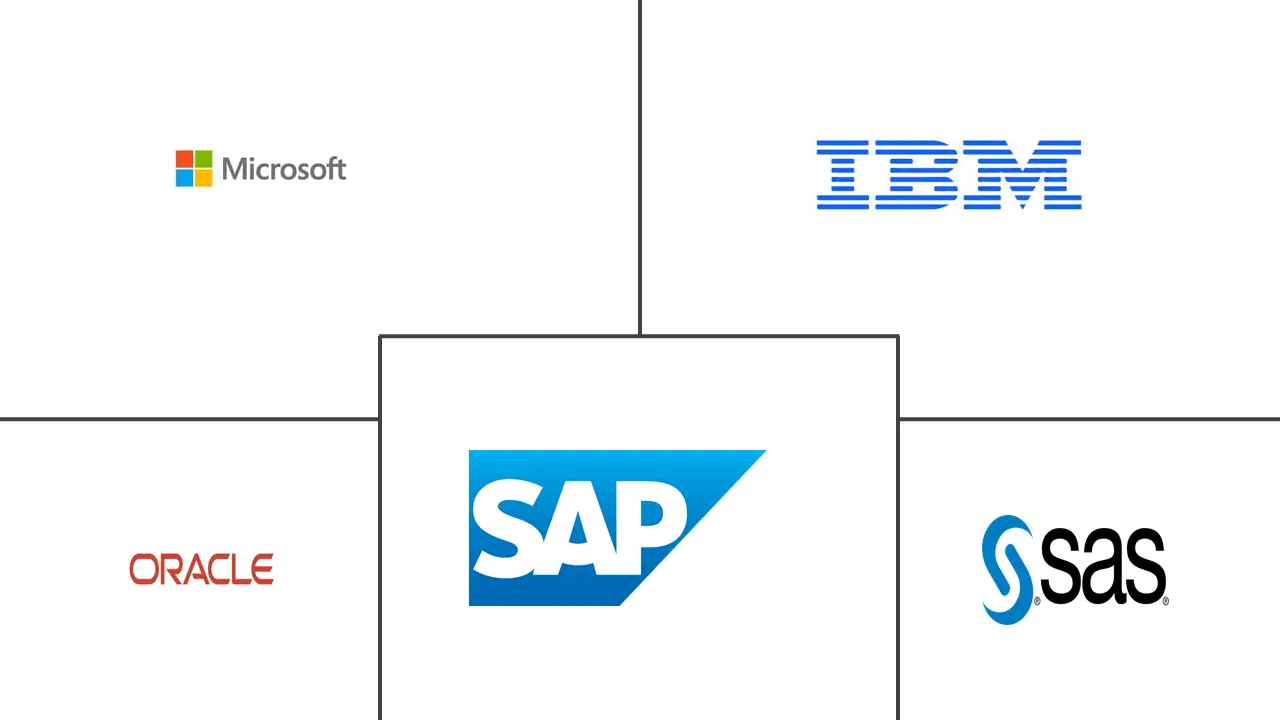
| Study Period | 2019 - 2029 |
| Base Year For Estimation | 2023 |
| Forecast Data Period | 2024 - 2029 |
| CAGR | 15.50 % |
| Fastest Growing Market | Asia Pacific |
| Largest Market | North America |
| Market Concentration | Low |
Major Players
*Disclaimer: Major Players sorted in no particular order |
Self-service BI Market Analysis
The self-service BI Market is expected to grow at a CAGR of 15.5% during the forecast period. Self-service Business Intelligence (BI) allows business users and operators to access business data and examine them to generate insights even if they do not have any data science and analytical skill and expertise. The Self-service BI market witnessed a noticeable adoption across numerous business fields such as marketing, sales, human resource, operations, and finance, attributed to thorough competitive analysis and comfort of application for non-technical staff.
- Self-Service BI aids business operators from non-analytical backgrounds to make insights and data analyses. The Self-service BI market is facing a growing demand for the business fields attributed to its capability to convert business establishments into efficient data-driven organizations or businesses. The Self-service BI market is projected to grow over the forecast period owing to its capacity to decentralize the business analytical process.
- The Self-Service BI market serves as an advantage to non-technical business customers for studying and analyzing data insights by guiding down the business data. The self-service BI market is rapidly rising because of the shift from conventional BI tools for business data analysis to contemporary BI tools, along with the growing market of structured and unstructured data.
- The principal drivers for the global self-service BI market are the rising demand for generating in-depth competitive data analysis and expanding the business data volume. Other factors that amplify and boost the growth of the global self-service BI market include persistent changing businesses, the need for an improved analytic-driven organization, and the inability to meet business requests within the stipulated time.
- Furthermore, substantial initial capital expenditure is necessary to install self-service BI systems which act as a hindrance to the market.
- During the Covid-19 pandemic, the self-service BI market rose as companies throughout the globe used BI and analytics to implement their goals and plans for survival. The expanding adoption of the work-from-home idea in areas such as IT and telecom, media and entertainment, healthcare, e-commerce, retail, and BFSI had increased demand for the self-service BI market.
Self-service BI Industry Segmentation
Self-service business intelligence software allows business users to implement and install analytics solutions without the assistance of IT or data professionals and carry out data analysis without any coding knowledge and understanding. These tools permit the average employee to gain understanding and insights from data to better inform business strategy and decision-making.
The Self-service BI Market is segmented by Type (Software, Services), by Application (Predictive Asset Maintenance, Fraud, and Security Management, Sales and Marketing Management, Risk and Compliance Management, Supply Chain Management and Procurement, Operations Management, Customer Engagement, and Analysis), by Deployment Model ( On-Demand, On-Premises), by End-User Industry (Healthcare, Manufacturing, BFSI, Retail and E-commerce, Telecommunications, Media and Entertainment, Transportation and Logistics, Energy, and Utilities, Government and Defense) and Region.
The market sizes and forecasts are provided in terms of value (USD million) for all the above segments.
| Software |
| Services |
| Predictive Asset Maintenance |
| Fraud and Security Management |
| Sales and Marketing Management |
| Risk and Compliance Management |
| Supply Chain Management and Procurement |
| Operations Management |
| Customer Engagement and Analysis |
| On-Demand |
| On-Premises |
| Healthcare |
| Manufacturing |
| BFSI |
| Retail and E-commerce |
| Telecommunications |
| Media and Entertainment |
| Transportation and Logistics |
| Energy and Utilities |
| Government and Defense |
| North America |
| Europe |
| Asia Pacific |
| South America |
| Middle East and Africa |
Self-service BI Market Size Summary
The self-service Business Intelligence (BI) market is experiencing significant growth, driven by its ability to empower non-technical business users to access and analyze data independently. This shift from traditional BI tools to more contemporary solutions is facilitating the transformation of organizations into data-driven entities. The market's expansion is fueled by the increasing volume of structured and unstructured data, the need for in-depth competitive analysis, and the demand for improved analytics-driven decision-making. Despite the challenges posed by substantial initial capital expenditures, the market is poised for growth as businesses seek to decentralize their analytical processes and enhance operational efficiency.
In the banking sector, the adoption of self-service BI tools is enabling financial institutions to better understand and meet customer needs, thereby enhancing cross-sell and up-sell opportunities. The rapid digitalization and technological advancements in recent years have further propelled the market, allowing banks to make informed financial and operational decisions. North America holds a significant share of the market, with major players like IBM, Oracle, and Microsoft driving development through innovation and strategic collaborations. The region's growth is supported by the increasing acceptance of cloud computing and the adoption of Big Data, which are expected to continue bolstering the self-service BI market in the coming years.
Self-service BI Market Size - Table of Contents
1. MARKET DYNAMICS
- 1.1 Market Overview
- 1.2 Industry Value Chain Analysis
-
1.3 Industry Attractiveness - Porter's Five Forces Analysis
- 1.3.1 Threat of New Entrants
- 1.3.2 Bargaining Power of Buyers/Consumers
- 1.3.3 Bargaining Power of Suppliers
- 1.3.4 Threat of Substitute Products
- 1.3.5 Intensity of Competitive Rivalry
- 1.4 Impact of COVID-19 on the Market
-
1.5 Market Drivers
- 1.5.1 The Growing Volume of Business Data
- 1.5.2 Augmented Need for In-Depth Competitive Insights
-
1.6 Market Restraints
- 1.6.1 Large Investment Costs
- 1.6.2 Lack of Data Governance
2. MARKET SEGMENTATION
-
2.1 By Type
- 2.1.1 Software
- 2.1.2 Services
-
2.2 By Application
- 2.2.1 Predictive Asset Maintenance
- 2.2.2 Fraud and Security Management
- 2.2.3 Sales and Marketing Management
- 2.2.4 Risk and Compliance Management
- 2.2.5 Supply Chain Management and Procurement
- 2.2.6 Operations Management
- 2.2.7 Customer Engagement and Analysis
-
2.3 By Deployment Model
- 2.3.1 On-Demand
- 2.3.2 On-Premises
-
2.4 By End-User Industry
- 2.4.1 Healthcare
- 2.4.2 Manufacturing
- 2.4.3 BFSI
- 2.4.4 Retail and E-commerce
- 2.4.5 Telecommunications
- 2.4.6 Media and Entertainment
- 2.4.7 Transportation and Logistics
- 2.4.8 Energy and Utilities
- 2.4.9 Government and Defense
-
2.5 Geography
- 2.5.1 North America
- 2.5.2 Europe
- 2.5.3 Asia Pacific
- 2.5.4 South America
- 2.5.5 Middle East and Africa
Self-service BI Market Research FAQs
What is the current Self-service BI Market size?
The Self-service BI Market is projected to register a CAGR of 15.5% during the forecast period (2025-2030)
Who are the key players in Self-service BI Market?
Microsoft Corporation, IBM, Oracle Corporation, SAP SE and SAS Institute are the major companies operating in the Self-service BI Market.


